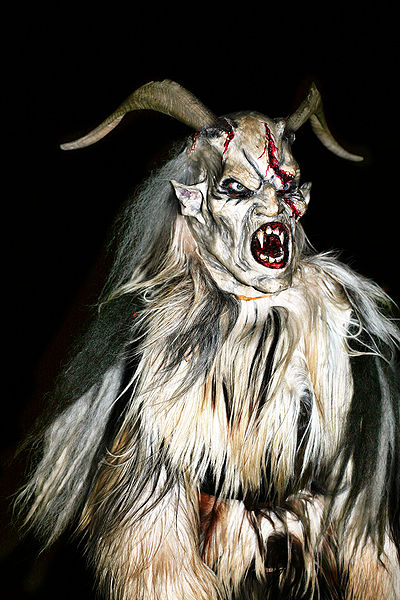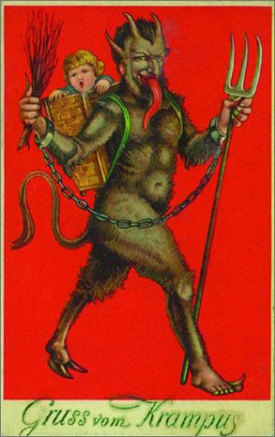Halloween isn’t the only season for monster sightings. Within Netherworld Haunted House a veritable army of unnatural beings lurk year round, seeking release from the confines of America’s leading haunted attraction. Ever plotting the downfall of humankind, the sinister forces of the Netherworld waste no time in hatching their evil schemes, hungry for mortal flesh and a taste of freedom. From cannibals to goblins to vampires to zombies, there is never a shortage of monstrosities lurking about.
Join us as we explore the many foul creatures that exist within Netherworld, and examine their hideous origins and legends. Each month we will unveil another nasty Netherspawn, to better prepare you, the human reader, for the ghastly ghouls you will encounter come fall 2012. Forewarned is forearmed. Or possibly four-armed, depending on your taste in monsters…
Netherworld creatures won’t kramp(us) your holiday style!
On any given evening, as the sun descends and the moon rises, giant shaggy brutes roam the grounds of Netherworld Haunted House, carrying switches and rattling rusty chains and bells as they search for bad children to stuff in their sacks and devour later in their fiery lairs.
Legend claims that these creatures, known as Krampus, accompany Saint Nicolas in Alpine countries during the Christmas season, to warn and punish the naughty while Jolly Ol’ Saint Nick rewards the good girls and boys. Typically bearing a devil-like appearance, with large horns, a monstrous tongue, cloven hooves, and thick fur, Krampus may also appear as a sinister gentleman dressed in black. Also known as Black Peter (as well as a host of other names in various regions – Kneckt Ruprecht, Pelzebock, Pelznickel (or Belznickel), Hans Muff, Bartel, Gumphinkel, and Stoppklos), these gruesome beasts offer a stark contrast in holiday punishment to the American lump of coal. Better not pout, indeed!
The origin of the Krampus dates back several thousand years, but traditions regarding the creature diminished until the mid-nineteenth century, when the idea of Saint Nicolas was revived in parts of Europe. The Krampus card gained popularity, and the legends began anew. However, following the 1934 Austrian Civil War, the Krampus tradition was prohibited by the Dollfuss regime. It returned after the end of World War II and remains a staple of the Christmas holiday today..
The Krampus is celebrated on Krampusnacht, taking place on December 5th – the eve of St. Nicholas’ Day in Austria, Northern Italy, France, Finland, and other parts of Europe. Costumed citizens disguised as devils, witches and man-beasts carry torches as they take part in the Krampus Run – or Krampuslauf – stalking the streets (often intoxicated, it would appear) and terrifying everyone they encounter. In some communities, they leer into childrens’ bedrooms from outside, warning of the need to be good, and are invited in by parents to drive the point home.
Europeans have long included Krampus in Christmas celebrations (vintage Krampus cards are a highly-sought after collectible, having exploded in popularity in the mid-nineteenth century), but US audiences are now getting in on the action. Krampus runs have sprung up in Oregon and Pennsylvania, to name a few, and the monsters have popped up in much American pop culture. There is even a Krampus beer – naturally.
Within the shadowy chambers of Netherworld Haunted House, Krampus have joined the dark sinister forces who attempt to unleash terror on the mortal realm. Working alongside gargoyles, goblins, nightmare kings and war beasts, they seek to secure innocent victims to whip with switches before feeding on their tender human flesh.
This year you may want to work a bit harder to stay off that naughty list…




